Robotic Lawn Mower Market Research, 2032
The global robotic lawn mower market size was valued at $838.5 million in 2022, and is projected to reach $2.4 billion by 2032, growing at a CAGR of 10.9% from 2023 to 2032.A robotic lawn mower is an autonomous machine used to maintain lawns and other grassy areas mechanically. These machines navigate lawns while avoiding obstacles and trimming grass to a certain height by using sensors, GPS technology, and sharp cutting blades. Users may control robotic lawn mowers through smartphone applications. Robotic lawn mowers are more convenient than typical gas-powered mowers since they do not require manual mowing, encourage regular grass preservation, and produce less noise and pollution.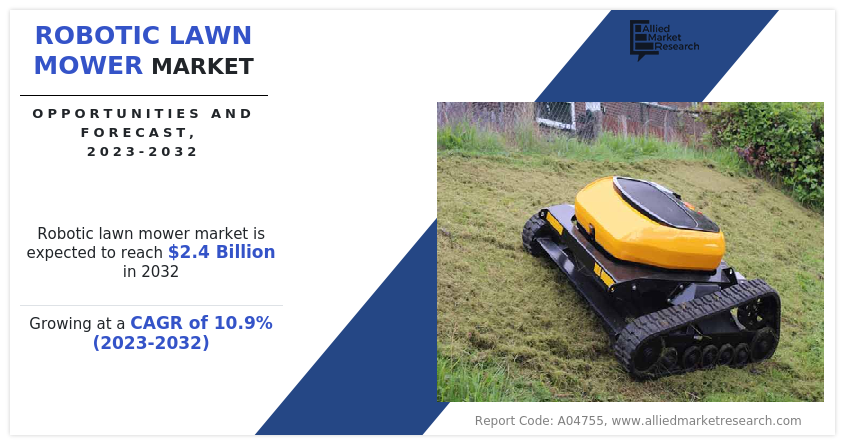
The market for robotic lawn mowers is significantly driven by the rise in demand for automation. Homeowners and property managers are often looking for methods to streamline their everyday duties and cut back on physical work in today's fast-paced environment. People are searching for smart, time-saving solutions that may improve their quality of life and provide quick solutions for maintaining their lawns & gardens. Robotic lawn mowers meet this demand by enabling consumers to hand off the duty of cutting the lawn to an autonomous device. Along with saving time, robotic lawn mowers also require less physical labor and monitoring which up to an extent decreases the requirement for human interference.
In addition, the trend towards automation aligns with environmental consciousness, as many robotic mowers are electric, emitting fewer pollutants compared to traditional gas-powered mowers. The demand for automation, coupled with the desire for eco-friendly solutions among consumers is propelling the robotic lawn mower market growth.
The market for robotic lawn mowers is greatly influenced by the introduction of technological advancements, which have attracted the interest of the consumer. These technological advancements have made conventional lawn care a more effective, practical, and ecologically beneficial activity. The introduction of cutting-edge features and capabilities into robotic mowers is one of the main drivers boosting this market. In addition, machine learning and algorithms are being used to improve the decision-making skills of robotic lawn mowers. To improve their effectiveness over time, they might adapt to changing grass growth rates, change their mowing schedules in response to weather predictions, and even learn from previous mowing sessions. These developments not only guarantee a well-kept lawn but also help consumers save time and energy.
Furthermore, the integration of smartphone apps and smart home technology has enabled them to operate their robotic mowers, establish mowing schedules, and receive notifications. The growth of the market has been witnessed as a result of the rise in consumer interest toward robotic lawn mowers and advancement in the technology development and effective lawn care solutions.
The demand for robotic lawn mowers is constrained largely by limited acceptance in developing economies and cultural and economic barriers. As the average income in developing countries is frequently lower, many buyers find the comparatively expensive upfront cost of robotic lawn mowers to be excessive. In addition, cultural perspectives on lawn work and the accessibility of inexpensive physical labor in certain areas might reduce the attraction of robotic options.
Furthermore, adoption might be hampered by a lack of supporting infrastructure. Electricity supply in many developing nations may be inconsistent or unstable, which is important for charging robotic lawn mowers. The convenience and effectiveness of these devices may be compromised by restricted or unavailable internet access for remote control and software updates. As robotic lawn mowers are less popular due to a lack of knowledge and education about them, this limits the growth of the market.
The market for robotic lawn mowers has a strong chance of expanding because of the rise in robotic lawn mower rentals and subscription services. With this creative solution, customers may make use of robotic lawn care equipment more conveniently and economically. Homeowners may get beyond the initial obstacle of the hefty upfront cost connected with owning these gadgets by choosing to rent or subscribe to services. Customers benefit from a reduction in their financial burden as well as flexibility, which enables them to use these robotic mowers seasonally without having to commit to long-term ownership. Additionally, this tendency encourages more customers to discover the time-saving and convenient benefits of robotic lawn mowers, hence increasing the potential client base. Additionally, businesses that provide rental and subscription services may build enduring bonds with their customers by maintaining and supporting them while generating a steady flow of income. Essentially, this new strategy is in line with customers' evolving tastes and budget-conscious outlook, and it will likely serve as a driving force behind the robotic lawn mower industry's sustained expansion.
The Internet of Things (IoT) has been on the rise for the past few years, which has influenced the growth of new technologically driven products. Lots of concepts have come up that combine, connect, collect, and exchange data, and provide opportunities for direct integration of the physical world with the virtual one. Both residential and commercial robotic lawn mowers are examples of this trend. Robotic lawn mowers are compatible with smartphones, and several other wireless technologies, allowing them to be controlled using smartphones. Smart homes are another example of IoT. A smart home is a residence that is equipped with electronic devices and can be operated remotely through a smartphone or a computer. The adoption of smart home concepts has increased in recent years due to its high energy efficiency and ability to reduce human effort and save time. The emergence of IOT is expected to provide lucrative opportunities for market growth in the coming years.
Segmental Overview
The robotic lawn mower market is segmented into range, end user, distribution channel, and region. By range, the market is classified into low range robotic lawn mower, medium range robotic lawn mower, and high range robotic lawn mower. As per end user, the market is classified into residential and commercial. By distribution channel, the market is classified into online and retail. Region-wise, the market is analyzed across North America (the U.S., Canada, and Mexico), Europe (France, Germany, the UK, Italy, Spain, and the Rest of Europe), Asia-Pacific (China, Japan, India, Australia, South Korea, and the rest of Asia-Pacific), and LAMEA (Brazil, Saudi Arabia, South Africa, the rest of LAMEA).
By Type
According to range, the medium range robotic lawn mower segment dominated the market in 2022 and is expected to maintain this trend during the forecast period owing to the increase in residential and commercial spaces such as buildings, corporate spaces, sports centers, and public parks, has fueled the requirement for medium range robotic lawn mowers.
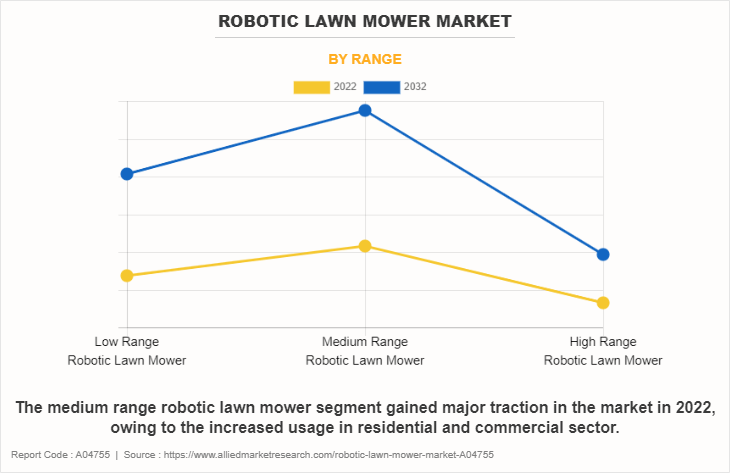
By End User
According to the robotic lawn mower market, on the basis of end user, the residential segment dominated the robotic lawn mower industry in 2022 and is expected to sustain its market share during the robotic lawn mower market forecast period, owing to the an increase in the demand for low and medium range robotic lawn mowers in the residential sector due to the increased requirement for lawn care and maintenance.
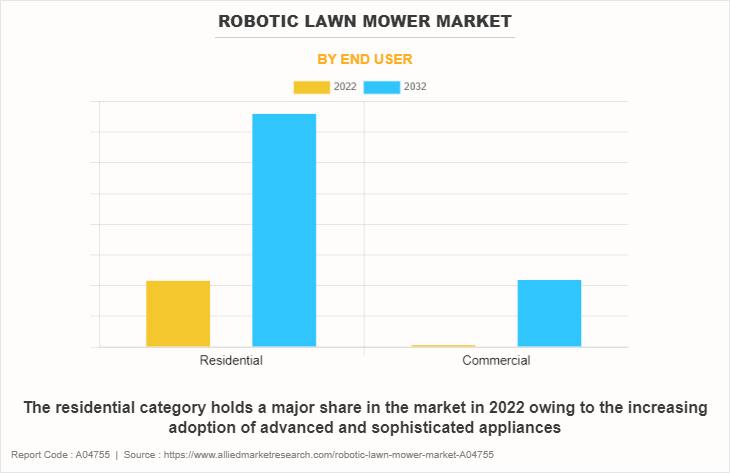
By Distribution Channel
According to the robotic lawn mower market demand, on the basis of distribution channel, the retail segment dominated the market in 2022 and is expected to sustain its market share during the forecast period. The increased demand for ecologically friendly and sustainable robotic lawn mowers, which is being driven by the rising awareness of environmental challenges, is one of the main factors boosting retail sales.
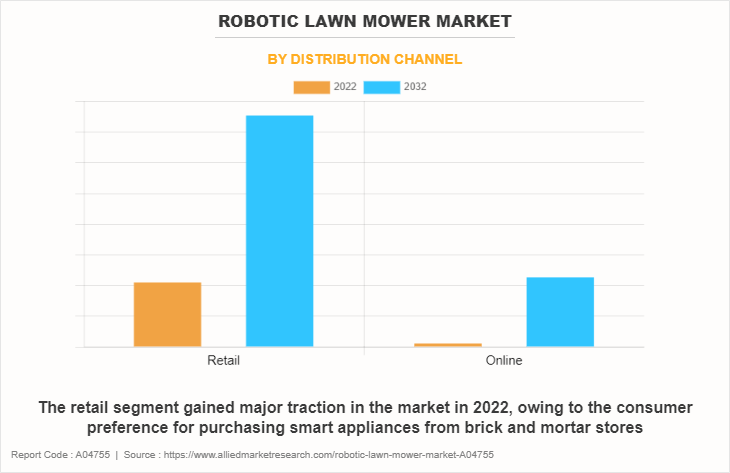
By Region
According to the region, Europe dominated the market in 2022 and is expected to be dominant during the forecast period. The growing popularity in artificial intelligence for performing day-to-day activities with higher efficiency is among the primary factors driving the Europe robotic lawn mower market.
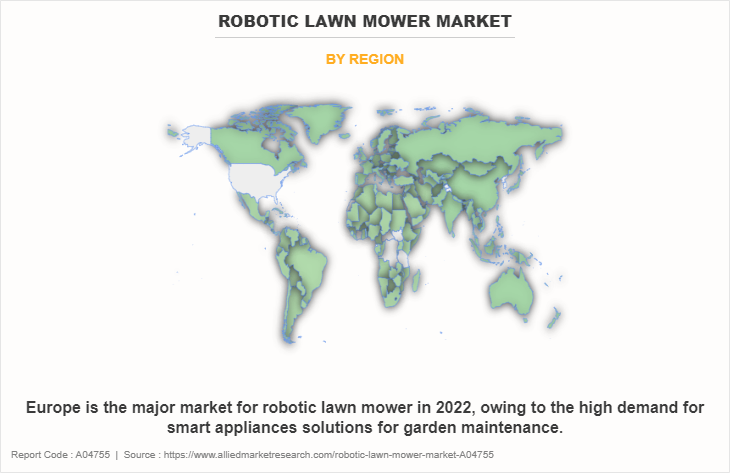
Competition Landscape
Players operating in the global robotic lawn mower market have adopted various developmental strategies to expand their robotic lawn mower market share, increase profitability, and remain competitive in the market. Key players profiled in this report include Robert Bosch GmbH, Husqvarna AB, Honda Motor Co., Ltd., Zucchetti Centro Sistemi S.p.A., Stiga C S.a.r.l., Andreas Holding AG & Co. KG, Positec Tool Corporation, Wiper S.R.L., Suzhou Cleva Electric Appliance Co., Ltd., and Stanley Black & Decker, Inc.
Examples of Acquisition in the Global Robotic Lawn Mower Market
- In January 2023, Robert Bosch GmbH acquired shares in the Swedish company Husqvarna AB, which offers robotic lawn mowers. The acquisition will increase its shareholding to roughly 12 percent of the company’s share capital in total.
- In August 2021, Stanley Black & Decker, Inc. acquired the remaining 80 percent ownership stake in MTD Holdings, Inc., a privately held global manufacturer of outdoor power equipment, including lawn mowers, to increase its customer base.
Examples of Product Launch in the Global Robotic Lawn Mower Market
- In April 2023, CRAFTSMAN, a brand of Stanley Black & Decker, Inc., announced the launch of several new electric outdoor products that include battery-powered mowers, cordless lawn and garden tools, and other related products to help its customers tackle lawn and garden chores with ease and efficiency.
- In March 2023, ANDREAS HOLDING AG & Co. KG launched the new iMOW robotic lawn mowers, available in two versions, which ensure a perfect cutting pattern and short mowing times, allowing garden owners to quickly use their lawns themselves again.
Key Benefits For Stakeholders
- This report provides a quantitative analysis of the market segments, current trends, estimations, and dynamics of the robotic lawn mower market analysis from 2022 to 2032 to identify the prevailing robotic lawn mower market opportunities.
- The market research is offered along with information related to key drivers, restraints, and opportunities.
- Porter's five forces analysis highlights the potency of buyers and suppliers to enable stakeholders make profit-oriented business decisions and strengthen their supplier-buyer network.
- In-depth analysis of the robotic lawn mower market segmentation assists to determine the prevailing market opportunities.
- Major countries in each region are mapped according to their revenue contribution to the global market.
- Market player positioning facilitates benchmarking and provides a clear understanding of the present position of the market players.
- The report includes the analysis of the regional as well as global robotic lawn mower market trends, key players, market segments, application areas, and market growth strategies.
Robotic Lawn Mower Market Report Highlights
| Aspects | Details |
| Market Size By 2032 | USD 2.4 billion |
| Growth Rate | CAGR of 10.9% |
| Forecast period | 2022 - 2032 |
| Report Pages | 250 |
| By Range |
|
| By End User |
|
| By Distribution Channel |
|
| By Region |
|
| Key Market Players | Husqvarna AB, ANDREAS HOLDING AG & Co. KG, Positec Tool Corporation, Suzhou Cleva Electric Appliance Co., Ltd, WIPER S.R.L., Honda Motor Co., Ltd., Stanley Black & Decker, Inc., Stiga C S.a.r.l., Zucchetti Centro Sistemi S.p.A., Robert Bosch GmbH |
Analyst Review
According to the CXOs of leading companies, the global robotic lawn mower market is emerging at a considerable pace owing to several factors such as an increase in awareness and compatibility of the robotic lawn mowers, enhanced sensors abilities, GPS navigation, smart control assistance, technology advancements, and growth in concerns about time saving. All these factors fuel the increase in sales of the robotic lawn mowers market.
Significant changes in the lifestyle of customers have witnessed an increase in the requirement for time-saving solutions, in turn resulting in the development of advanced and innovative robotic lawn appliances.
The popularity of robotic lawn mowers is significantly influenced by the growing retail and commercial sectors. The availability of appliances to customers is a growing concern. The expansion of the market for specialty shops, supermarkets, and hypermarkets is major traction in the global market. This is largely attributable to the abundance of alternatives available to customers. For the single-line product area, multi-brand specialty stores carry a variety of brands so that customers may evaluate their features and colors before making a purchase.
The robotic lawn mower size was valued at $838.5 million in 2022 and is projected to reach $2,353.2 million by 2032, growing at a CAGR of 10.9% from 2023-2032.
The global robotic lawn mower market registered a CAGR of 10.9% from 2023 to 2032.
Raise the query and paste the link of the specific report and our sales executive will revert with the sample.
The forecast period in the robotic lawn mower market report is from 2023 to 2032.
The top companies that hold the market share in the robotic lawn mower market include Robert Bosch GmbH, Husqvarna AB, Honda Motor Co., Ltd., Zucchetti Centro Sistemi S.p.A, and others.
The robotic lawn mower market report has 3 segments. The segments are range, end user, and distribution channel.
The emerging countries in the robotic lawn mower market are likely to grow at a CAGR of more than 11.0% from 2023 to 2032.
: Post-COVID-19, global industry is expected to grow at a high rate as market leaders adopt new partnerships for introducing smart appliances and offer unique experience to the consumers.
Europe will dominate the robotic lawn mower market by the end of 2032.
Loading Table Of Content...
Loading Research Methodology...


